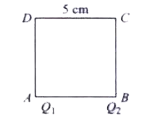(a) How many electorns are in 1C of negative charge?
(b) Which is the true test of electrification: attraction or repulsion?
(c ) Can a body have a charge of 0.8×10−19C ?
(a) q=ne
n=qe=11.6×10−19=6.25×1018
(b) Repulsion. As charged body can attarct uncharged body.
(c ) No, as charge is quantized.
Topper's Solved these Questions
- COULOMB LAW AND ELECTRIC FIELDBook:CENGAGE PHYSICSChapter:COULOMB LAW AND ELECTRIC FIELDExercise:Subjective
Explore 32 Videos
- COULOMB LAW AND ELECTRIC FIELDBook:CENGAGE PHYSICSChapter:COULOMB LAW AND ELECTRIC FIELDExercise:Single Correct
Explore 47 Videos
- COULOMB LAW AND ELECTRIC FIELDBook:CENGAGE PHYSICSChapter:COULOMB LAW AND ELECTRIC FIELDExercise:Solved examples
Explore 10 Videos
- COMMUNICATION SYSTEMBook:CENGAGE PHYSICSChapter:COMMUNICATION SYSTEMExercise:QUESTION BANK
Explore 19 Videos
- Current ElectricityBook:CENGAGE PHYSICSChapter:Current ElectricityExercise:QUESTION BANK
Explore 40 Videos
Similar Questions
Knowledge Check
Is a charge of (5.8×10−18)C possible?
AyesBNoCMay beDCannot be determinedHow many number of electrons are present in a particle which carries a charge of 5.5×10−16C?
A3432B1560C8240D2432How many electrons would have to be removed from a copper penny to leave it with a positive charge of 10−7C ?
A6.25×10−11B6.25×10−12C6.25×1011D6.25×1013
It is not possible to have a particel with charge 20xx10^(-19) C.
View SolutionCharges 2×10−6Cand1×10−6C are placed at comers A and B of a square of side 5 cm as shown in the figure. How much work will be done against the electric field in moving a charge of 1×10−6C from C to D?

View Solution(a) A body is having charge +4.8×10−18C. Estimate the number of electrons in excess/shortage.
(b) A body is having charge 3×10−12C. Determine whether this statement is true/false.
(c) Estimate the number of electrons in 36g of water. How much is the total negative charge on these electrons.
(d) Estimate the charge in 26g of Na+.
View SolutionHow many electrons pass through a lamp in 2 minutes, if the current is 300 mA. Given that charge on an electron is 1.6×10−19C.
View SolutionAn ebonite rod acquires a negative charge of 3.2×10−10 C. The number of excess electrons it has is given by
View Solution
